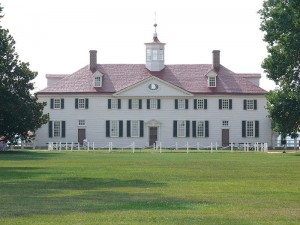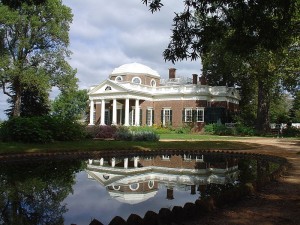Intimate lives on display: Monticello and Mount Vernon
05 March 2014 – Thomas Foster
Jennifer Tyburczy’s brilliant observation that all museums “have played an important but often overlooked role in the institutionalization of categories of sexual ‘normalcy’ and ‘perversity’” can also be applied to house museums and historic sites. House museums, as sites for interpreting private lives, are engaged in complex ways with presentations of sex and sexuality. The most famous and oft-visited house museums in the United States are George Washington’s plantation Mount Vernon and Thomas Jefferson’s mountain-top plantation, Monticello. Mount Vernon receives one million visitors each year and Monticello some 500,000. Monticello and Mount Vernon serve as case studies to illustrate the physical and inter-personal ways in which house museums convey information about the Founders’ personal lives.
One obstacle to this type of personalizing of the two men is that both run afoul of traditional norms of masculinity. George Washington, not everyone realizes, had no children of his own. In today’s climate, this potentially raises questions about masculine virility, marital problems, or even sexual orientation. Thomas Jefferson, as most people know, has been linked to extra-marital sex as public memory of Jefferson now acknowledges a sexual relationship with an enslaved woman that took place when Jefferson was a widower.
Mount Vernon and Monticello both overcome these obstacles to masculine presentation by putting forth a version of history that entertains visitors and educates them about the individual’s lives. At Mount Vernon this largely involves emphasizing marriage and family while at Monticello directly addressing the topic has become the norm.
![Photo courtesy of Gilbert Stuart [Public domain], via Wikimedia Commons.](https://ncph.org/wp-content/uploads/2014/02/Gwashington-189x300.jpeg)
Official Presidential portrait of George Washington, c. 1797. Photo credit: Portrait by Gilbert Stuart [Public domain], via Wikimedia Commons
At the Donald W. Reynolds Museum and Education Center, a film devoted to the Washingtons’ marriage, titled “A Very Private Romance,” suggests that the children of the household are George and Martha Washington’s. In the film, George Washington is depicted as interacting with Martha Washington’s children and being called “papa,” but we’ve not been told that they are her children from a previous marriage, so the assumption might be that they have had children together. At the museum, one exhibit devoted to the marriage repeats the main themes of the film–that the marriage was romantic and private and one of devotion. Indeed, visually, once again it is suggested that they had children together. This is accomplished with an attractive full-wall mural of a family tree. It is depicted as a tree, monochromatic in green tones, and so it’s quite difficult to discern whose children descend. George and Martha Washington, and Martha’s first husband (Daniel Parke Custis) all occupy the top level, but the ribbons emanate only from the Custis line.
If the absence of information about Washington’s childlessness serves a certain purpose, it cannot be simply respecting the privacy of this public figure. Repeatedly the museum and house put forth intimate details of the romantic nature of the first couple’s marital life. Indeed, the two approaches work in tandem to shore up Washington’s personal life as traditional.
Mount Vernon has both drawn on and furthered the portrayal of Washington as normative husband and idealized father found in popular biographies. Unlike the biographies that in greater detail discuss sex scandals during his lifetime (and raise possible questions about his monogamy) or the literature that argues he fathered a child with one of his slaves, the house museum focuses solely on the themes of head of household and loving husband.
The type of side-stepping that occurs at Mount Vernon was precisely the approach at Monticello in previous generations regarding Thomas Jefferson’s connection to the enslaved woman, Sally Hemings. Today, however, visitors to Monticello are confronted almost immediately with the well-known controversy regarding his relationship with Hemings.
The buildings and grounds themselves present no obvious indicators of his family life or his involvement with Hemings. Indeed, until only recently the issue of slavery itself was so masked at the site that the relationship with Hemings lacked any possible context for discussion. Popular media has romanticized their relationship and has provided the public with a memory of Jefferson and Hemings not supported by documentary evidence. Some tourists arrive wanting to see the physical evidence of the relationship, asking to see the secret room or secret passage they believe was built to accommodate Hemings and facilitate the relationship, even though no such structures exist. Monticello reflects Jefferson’s own hand in developing public memory of his personal connection to Hemings, given that he famously hid the connection and preserved no material objects that speak to it.
![Official Presidential portrait of Thomas Jefferson, ca 1800. Painting By Rembrandt Peale [Public domain], via Wikimedia Commons.](https://ncph.org/wp-content/uploads/2014/02/Official_Presidential_portrait_of_Thomas_Jefferson_by_Rembrandt_Peale_1800-251x300.jpg)
Official Presidential portrait of Thomas Jefferson, c. 1800. Photo credit: Painting by Rembrandt Peale [Public domain], via Wikimedia Commons
In the context of the tour, presenting Jefferson as a man of the Enlightenment, and in the absence of any discussion of sexual exploitation, it is impossible for visitors to view this relationship as anything other than ahead of its time.
In the context of the overarching theme of Jefferson as a man who devoted his life to liberty and human rights, it is impossible to view his siring children with Sally Hemings as the rape or sexual exploitation of a young enslaved woman. Although the scholarly literature on sex between masters and slaves emphasizes exploitation, popular memory of Jefferson has characterized the relationship as romantic and tender. The tourists at Monticello are presented with a similar view. Although very carefully worded, the statements in the brochure, voiced by tour guides at the mansion and on the slave life tour, and presented at the museum in both written form and in a film, all portray it in terms that suggest consent – a “relationship,” he “fathered” her children, had a “second family.” When such limited and suggestive information is presented alongside the extraordinary accomplishments and the theme of genius, contemporary visitors would likely conclude that the relationship was also ahead of its time–love “across the color line” and stripped of the extreme power imbalance that in fact existed between them.
Monticello has aggressively captured this view of Jefferson and narrows it from the broader literature. At the plantation one cannot see any discussion of any other romantic connections of Jefferson’s. The effect is to foreground his status as a widower and as head of household and as father of Hemings’ children.
The plantations Monticello and Mount Vernon borrow from, depart from, and contribute to popular memory in significant ways. Reacting in part to the relatively recent historical inquiry into the lives of ordinary Americans, their image-makers have sought to depict Washington and Jefferson as still relevant for a populace that sees elite, slave-holding men as less and less the central focus of early American history. Unlike the popular biographies, films, and novels that focus on Jefferson’s and Washington’s entire lives, house museums highlight domestic life disproportionately. Popular biographies, for example, spend a great deal of time and energy exploring early loves, a topic virtually absent from the house museums. By their nature and setting, house museums thrust visitors into a total sensory experience that evokes domesticity, marriage, family, and monogamy. As such, Monticello and Mount Vernon establish a normative sexuality for Jefferson and Washington in a manner that is far less complicated than depicted in popular sources, such as biography.
By examining how sex figures in depictions of the lives of Jefferson and Washington at Monticello and Mount Vernon, we can see that stories of intimate life continue to be used to define their masculine character and political authority. That this occurs at house museums–as the sites of their intimate lives–this should come as no surprise, but we should question the narratives that are told and those that are silenced as we grapple with how best to display the personal lives of these public figures.
~Thomas A. Foster is the author of Sex and the Founding Fathers: The American Quest for a Relatable Past (Temple University Press).






I’ve never been to Mount Vernon or Monticello and I have little desire to go despite my lifetime interest and devotion to history. Part of the reason is because of the deceptive and allusive dialogue about these two founding fathers. As a new public historian, I understand that the sites/houses might not want to become rumor mills. That would be an injustice to historical academic integrity. Yet, I think both sites could profit by presenting these presidents as men not a concept. Great article.
Sorry, I didn’t include my correct website/blog: http://www.historicallycourtney.wordpress.com
This blog post arrives with perfect timing – just met with a student who wants to write her thesis on the women in presidents’ intimate lives… Congratulations on the book Thomas – can’t wait to read it!
The Monticello treatment of the Jefferson-Hemings DNA Study is very muddled and confusing to the public because I assisted Dr Foster with the study and NOTHING proves that Thomas Jefferson fathered any slave child and Dr Foster acknowledged this in many articles and in many e-mails to me.
I will never attend Monticello again and you may wish to consider any such action. Only one Hemings was tested YET they indicate ALL of Sally’s child
ren were sired by TJ. The public is being very badly misinformed by such claims for politically correct reasons. This is a slavery issue NOT one of truth about the DNA study.
Herb Barger
Founder, Thomas Jefferson Heritage Society
http://www.tjheritage.org
http://www.jeffersondnastudy.com
EDITOR’S NOTE: The “Dr. Foster” in the above post is likely referring to pathologist Dr. Eugene Foster (who died in 2008), not to the author of the blog post, “Intimate Lives…” (Prof. Thomas Foster).